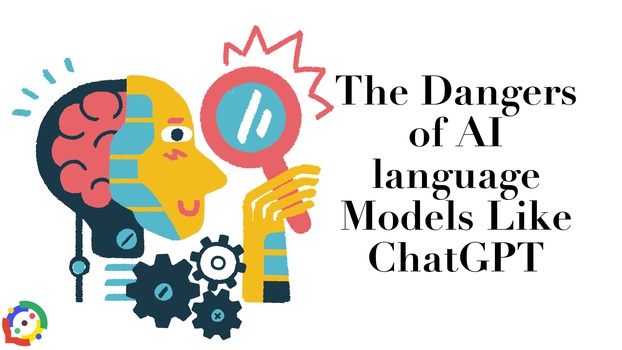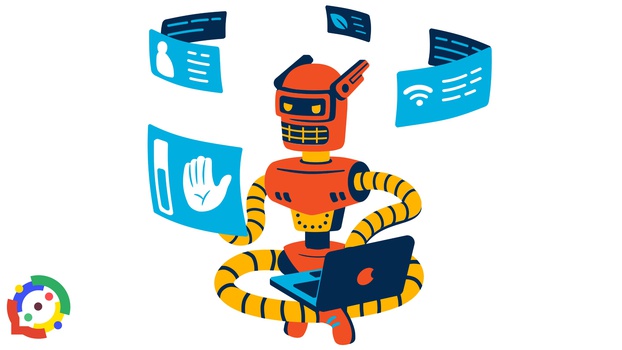The Dangers of AI language Models Like ChatGPT
Artificial Intelligence (AI) has revolutionized many aspects of our lives, from healthcare to transportation, and has the potential to continue transforming the world in countless ways. One of the most significant developments in the field of AI is the creation of language models, such as ChatGPT, which are capable of generating natural language responses to text prompts. While these models offer numerous benefits and have a wide range of applications, they also pose significant dangers that must be addressed.
In this blog post, we will explore the dangers of AI language models like ChatGPT. We will examine specific examples of these dangers in action and discuss their implications for society. While AI language models hold great promise, it is essential that we understand and address their potential risks to ensure that they are developed and used in a responsible and ethical manner. Join us as we delve into the complex and important topic of the dangers of AI language models.

What are AI Language Models
AI language models are a type of artificial intelligence that are designed to process and analyze natural language data, such as text or speech, and generate human-like responses. These models use complex algorithms and machine learning techniques to identify patterns and relationships in language data, and use this information to generate natural language responses to text prompts.
The increasing popularity of AI language models can be attributed to several factors. First, advances in machine learning and natural language processing techniques have made it possible to develop increasingly sophisticated and accurate language models. Second, the explosion of digital data has created a wealth of language data that can be used to train and improve these models. Third, the rise of chatbots, virtual assistants, and other conversational AI applications has created a growing demand for language models that can generate natural language responses in real-time.
As a result, AI language models like ChatGPT have become increasingly popular and widely used in a variety of applications, including customer service, marketing, healthcare, education, and more. However, as we will explore in this blog post, the growing use of AI language models also poses significant dangers that must be addressed.
Dangers of AI Language Models
While AI language models like chatGPT have shown great potential in various applications, their widespread use also comes with several inherent dangers. Let us explore some of the most significant dangers associated with AI language models in their development and deployment. It is essential to understand these dangers to ensure that we use these powerful tools in a responsible and ethical manner.
A. Bias
AI language models like chatGPT are not immune to the biases that exist in society. In fact, they can inadvertently perpetuate and amplify these biases. This is because AI language models learn from the data that is fed into them, which can contain implicit biases that are present in society.
For example, if an AI language model is trained on data that is predominantly male, it may be more likely to generate responses that are biased towards men. Similarly, if the data contains racial or cultural biases, the language model may perpetuate these biases in its responses. This bias can have serious implications for individuals and society as a whole. It can perpetuate stereotypes and discrimination, leading to unfair treatment and opportunities for certain groups. In addition, biased language models can undermine trust in the technology and reduce its effectiveness.
There have been several examples of biased language models in action, such as chatbots that have been found to be sexist or racist in their responses. For example, Microsoft's chatbot, Tay, was shut down within 24 hours of its launch in 2016 because it began spewing racist and sexist comments.
How To Deal With Bias AI Language Models
Dealing with bias in AI language models requires a concerted effort from both users and developers. As users, one way to address bias is to be aware of its existence and to actively seek out and use language models that have been designed to address bias. This means looking for models that have been trained on diverse datasets, and that have been evaluated for bias and fairness.
Users can also report instances of biased language generation to developers and data scientists, and provide feedback on how to improve the model. It is important to remember that AI language models are only as unbiased as the data they are trained on, so it is crucial to ensure that the data used to train these models is diverse and representative of all users.
Addressing bias in AI language models is critical to ensuring that they are used in a responsible and ethical manner. This requires careful consideration of the data used to train these models and the development of methods to detect and address bias in their responses.
B. Misinformation and Manipulation

AI language models like chatGPT can be used to generate large amounts of text quickly and convincingly, making them a powerful tool for spreading misinformation and propaganda. For example, AI-generated text can be used to create fake news articles or social media posts that appear to be genuine.
One example of AI-generated misinformation is the creation of deepfake videos, which use AI to manipulate video and audio to make it appear as though someone is saying or doing something they did not. Deepfakes have been used to create convincing videos of politicians making false statements or celebrities engaging in illegal activities.
The implications of AI-generated misinformation and manipulation are significant. It can erode trust in information sources and undermine the public's ability to make informed decisions. This can have far-reaching consequences, from affecting election outcomes to causing public panic and unrest.
How to Deal with AI Language Models' Misinformation and Manipulation
First, it is important to be vigilant about the sources of information and to fact-check any information before sharing or acting on it. Second, users can learn to recognize common patterns of AI-generated content, such as overly-sensational headlines or sources that are not reputable. Third, people can take steps to limit their exposure to AI-generated content by adjusting their social media settings and avoiding suspicious websites or sources. Advocacy for stronger regulation and ethical standards for the development and use of AI language models can also be an effective way to address these issues at a larger scale.
It is essential to develop strategies to detect and combat AI-generated misinformation and manipulation. This includes improving media literacy and critical thinking skills, as well as developing AI tools to detect and counteract fake content. Additionally, AI developers must consider the ethical implications of their technology and develop guidelines to ensure its responsible use.
C. Lack of Accountability

One of the key concerns with AI language models like chatGPT is the lack of accountability for their use. Unlike human decision-making, AI decision-making is often opaque and difficult to understand, making it difficult to determine who is responsible when things go wrong.
While the creators of AI language models can be held accountable for their development, it can be challenging to hold them accountable for their use. For example, if an AI language model generates biased or misleading content, it can be challenging to determine who is responsible for that content.
The lack of transparency in AI decision-making can make it difficult to understand why certain decisions are being made. This can lead to a lack of trust in the technology, particularly when it comes to decisions that affect individuals' lives, such as credit scores or job opportunities.
How to deal with AI Language Models' Lack of Accountability
One approach is to demand greater transparency from the creators of these models. This can involve asking for more information about how the models were trained, what data was used, and how decisions are made. Users can also advocate for ethical standards and regulations to be put in place to ensure that AI language models are developed and used responsibly. Users can be vigilant and critical of the information generated by AI language models, checking for bias, misinformation, and errors.
The implications for accountability and responsibility in AI development are significant. It is essential to establish clear guidelines for the responsible use of AI, including accountability mechanisms for when things go wrong. This includes developing tools for auditing and evaluating AI decision-making, as well as guidelines for ethical AI development.
Developers must also prioritize transparency in AI decision-making to ensure that individuals understand how and why decisions are being made. This includes making the decision-making process more transparent and providing clear explanations for how decisions are reached.
By prioritizing accountability and responsibility in AI development, we can help ensure that these technologies are used in a responsible and ethical manner. This will be critical as AI becomes increasingly prevalent in our lives.
D. Unchecked Automation

Unchecked automation is another significant danger posed by AI language models. With the ability to generate large volumes of content automatically, there is a risk that data will be recycled in a way that creates a lack of originality and creativity in the content produced. This is because AI language models use information from previous content to generate new content, resulting in a lack of diversity in the ideas and themes presented. This issue can be observed in social media automation, where many accounts use bots to generate posts that are identical or nearly identical to one another.
The erosion of the human touch is another concern related to unchecked automation. While AI language models are capable of generating natural language responses, they lack the nuance, context, and emotional intelligence that human communication provides. As a result, the content produced by AI language models may lack the warmth, empathy, and creativity that comes with human interaction. This can result in a disconnection between the content and the audience, as well as a lack of authenticity and trust.
How to Deal with AI Language Models’ Unchecked Automation
Unchecked automation in AI language models can be addressed by implementing human oversight and review processes. This involves having a human editor or reviewer check the content generated by the AI language model for errors, biases, and lack of originality. By having human oversight, we can ensure that the content produced by the AI language model is accurate, diverse, and relevant to the intended audience.
Another approach to dealing with unchecked automation is to use AI language models in conjunction with human input. For example, companies can use AI language models to generate an initial draft of a document and then have a human editor or writer refine the content, adding originality, creativity, and the human touch to the final product.
It is also important to recognize the limitations of AI language models and not rely on them as the sole source of content generation. Instead, AI language models should be used as a tool to assist humans in their work, rather than replacing them altogether.
Finally, it is crucial to promote education and awareness around the potential risks of unchecked automation in AI language models. By increasing public understanding of the limitations and potential biases of AI language models, we can help ensure that their development and use are guided by ethical and responsible principles.
Positive Aspects of AI Language Models

AI Language Models, such as ChatGPT, have several positive aspects that make them valuable tools for a variety of applications. Here are some of the positive aspects of AI Language Models:
- Increased Efficiency: AI Language Models can process vast amounts of text data quickly and accurately, providing significant time and cost savings compared to traditional manual methods.
- Improved Customer Experience: AI Language Models can be used to develop chatbots and virtual assistants that provide fast, accurate, and personalized responses to customer inquiries, improving the overall customer experience.
- Enhanced Communication: AI Language Models can be used to facilitate communication between individuals who speak different languages, breaking down language barriers and promoting understanding and collaboration.
- Better Decision Making: AI Language Models can be used to analyze large volumes of data, identify patterns and trends, and make more informed decisions, particularly in industries such as finance, healthcare, and marketing.
- Innovative Applications: AI Language Models can be used in a variety of innovative applications, including creative writing, generating text for video games, and developing AI assistants for individuals with disabilities.
AI Language Models have the potential to transform many aspects of our lives, from improving communication and decision-making to enhancing customer experiences and facilitating innovation. However, it is essential to recognize the potential risks associated with these technologies and prioritize responsible development and use.
Conclusion
In conclusion, AI language models like chatGPT are powerful tools that have the potential to transform many aspects of our lives. However, they also pose significant dangers that must be addressed.
As AI technology continues to advance, it is critical that we prioritize responsible development and use. This includes developing ethical guidelines and accountability mechanisms, promoting transparency in decision-making, and addressing the potential risks associated with the technology. By addressing the dangers of AI language models and promoting responsible development and use, we can help ensure that AI technology is a force for good in the world.
Get started
Just because there are dangers associated with AI Language Models that does not mean we should stop using them, there are a lot of benefits we get from using AI Language Models Such as MobileGPT. Register quickly with a free trial, no sign-ups, no strings: https://wa.me/message/TRQTFU2TZDBGP1









